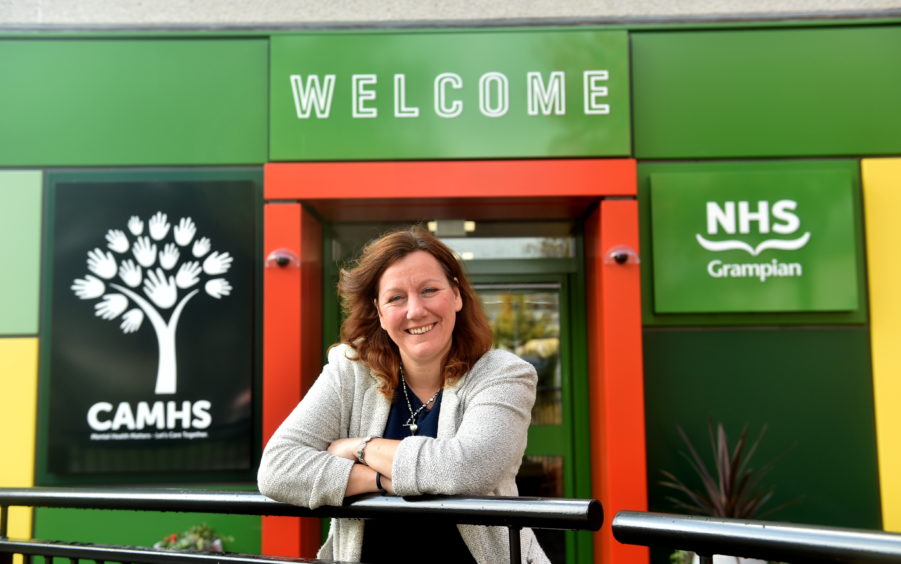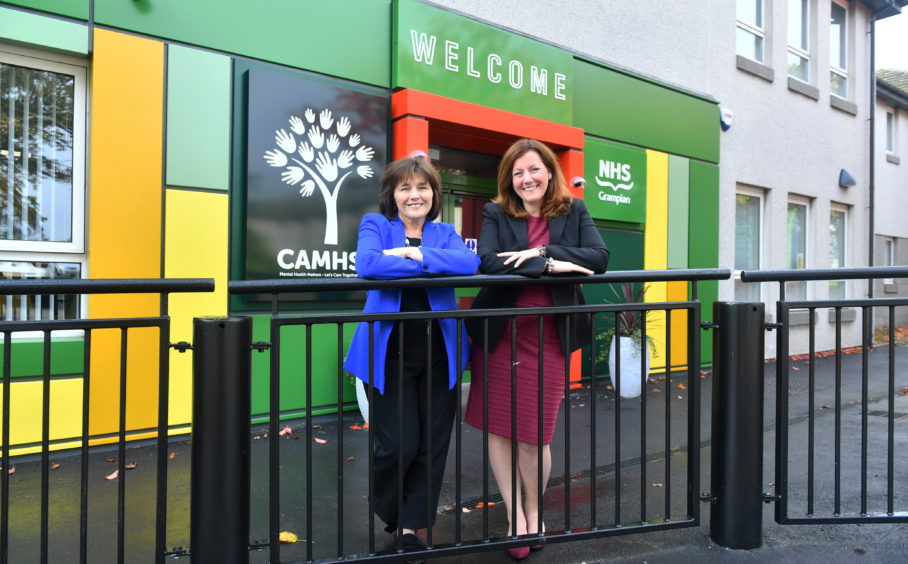The waiting room is bright and welcoming, with cheerful staff on reception.
The children’s corner boasts an impressive selection of toys, from a bright yellow digger to bean bags and a huge plastic teapot.
Books have been left haphazardly on the shelves, but this area is well used as opposed to untidy – with toys clearly abandoned mid-play when young patients were called.
The scene will strike a chord with weary parents everywhere, reminiscent of Lego-strewn living rooms up and down the country.
But the home-from-home vibe is deliberate, a slither of detail which could make a scared patient feel more comfortable.
High-backed seating areas offer privacy, and an infant feeding room enables mums to bring younger siblings along without feeling self-conscious.
This is CAMHS, the child and adolescent mental health unit in Aberdeen.
It still smells of fresh paint and newness, having only been open for three months in its new location on the city’s Urquhart Road.
The building on the City Hospital site has undergone a mammoth spruce-up.
It is now a one-stop shop for children from the ages of zero to 18, who have been referred for mental health treatment.
A team of dedicated staff help the dozens of youngsters who come through the door, some with complex mental health issues which can range from eating disorders to schizophrenia.
According to research published by BookTrust, 53% of parents said that in the past 12 months their child has shown signs of emotional stress or anxiety.
Staff at CAMHS have noticed an increase in the number of patients requiring treatment for anxiety, although they see a wide spectrum of issues.
Dr Lynne Taylor, who is lead consultant psychologist and clinical director for CAMHS, showed your life around the centre in a bid to shine a light on the treatment available.
We meet in a private lounge, where there are plush blue sofas, a TV and a small kitchen.
It’s about as far away from a medical environment as you can get, despite the fact this room is used for the most severe cases.
“This is what we call tier four, where we see our most unwell patients,” said Dr Taylor.
“We do not have an in-patient unit for children or adolescents in Aberdeen.
“The closest would be Dundee.
“The services we offer means we try and help patients to the extent that they don’t require an in-patient stay.
“We provide an intensive out-patient unit instead. Every detail of this room has been thought out.
“It’s comfortable and it keeps patients safe.
“You can’t throw the furniture, it’s weighted down.
“There are no door handles because this room is ligature free.
“And you can’t smash the TV because it’s encased behind another screen.
“This room is typically used for a half-day assessment, and there is a small kitchen so parents can make refreshments.
“If you’ve been up all night with a child who is suicidal, this room can be a godsend.
“The centre opened at the start of June; we want it to be a one-stop-shop centre for excellence.”
Dr Taylor takes me on a guided tour, pointing out what she calls “sub waiting” areas – where patients can sit if they feel overwhelmed in the main waiting area at reception.
There’s even a therapy kitchen, but we don’t go in due to patient confidentiality.
“We are certainly seeing more cases than, say, five or 10 years ago, and a huge proportion of the children we see have been referred on the basis of anxiety,” said Dr Taylor.
“We tend to see youngsters who need extra help and intervention.
“Parents and carers can’t make referrals. But we have changed the policy, as previously a referral could only be made by the GP.
“But the GP is seeing a snapshot of the child in that moment, whereas someone like a head teacher is more likely to know that something may be not quite right.
“Guidance teachers and school doctors, school nurses or a health visitor can also refer a child to CAMHS.
“Mental health problems present differently in every child.
“Some youngsters tend to try and hide the problem away, because they feel they’ve let others down.
“Be that the school, their parents, or even themselves; they feel a huge amount of pressure.
“Anxiety can also manifest physically.
“A child could struggle to sleep or have a sore tummy and feel sick.
“They feel like their mind is going too fast and their heart is racing.
“Or they struggle to eat, there’s a whole host of symptoms.”
The centre operates a choice and partnership approach, Capa.
This means a patient is offered an appointment, and must phone to arrange it.
All patients are encouraged to be seen with their family present, but children of secondary school age can ask to be seen alone.
Youngsters are then assessed to decide what type of support is needed.
“Our patients always have the choice as to whether to keep coming to CAMHS,” said Dr Taylor.
“We have an excellent team here, we try to match the patient to the skills set of staff members.
“There’s a wide range of treatments as well.
“Cognitive behaviour therapy (CBT) has proven to be very effective in treating anxiety, for example.
“Medication can also be appropriate, but we try not to prescribe to young children.
“It’s usually only appropriate when psychological therapies haven’t worked.”
As to the increase in the number of children accessing mental health services in recent years – the centre has treated more than 530 new cases since opening in June – Dr Taylor has several theories.
“There isn’t a straight answer,” she said.
“Having a mental health problem and seeking help for it is much more accepted.
“A decade ago, there could have been just as many young people struggling.
“But it’s only now that they are saying something, perhaps.
“Of course social media plays its part, as does the fact that news is readily available.
“Children aren’t protected from the news anymore, so they naturally feel more anxious as to what’s going on in the world.
“Ironically, children are protected by their family more than ever before, in the sense you don’t have children going out to play all day anymore.
“Children are taught that the world is a dangerous place, so their feeling of safety is altered.”
A new project led by staff at the centre has also enabled teachers to deliver mental health support in school.
The project, which is called low intensity anxiety management, was rolled out in three pilot areas last year.
“It means staff in schools are trained by us to deliver six sessions of CBT to pupils who need it,” said Dr Taylor.
“The outcome has been fantastic and we are now rolling it out across further schools. We run lots of different groups at the centre as well, including an anxiety group with a focus on how to manage it.
“There have been calls for a parent-led support group, and I think that’s really important.
“If you are the parent of a child who has anxiety or any other mental health problem for that matter, you’ll know it’s still a taboo to an extent.
“There’s this stigma attached.
“A lot of parents blame themselves, and there’s the belief that the problem stems from one life event.
“That isn’t the case at all, sometimes it could just be how the child is.
“We run two evening clinics to make it easier for working parents to attend, and we can offer encrypted Facetime appointments if it suits the patient.
“Weekend clinics could also be a possibility in the future.”
ZOE’S STORY
For mum-of-two Zoe Buchan, anxiety has become a part of everyday life.
The hairdresser, who lives in Cruden Bay, has been trying to help her oldest daughter, Lilly, with her battle against anxiety.
“Lilly is five, but she experienced anxiety from an early age,” said Zoe.
“I’d leave her at twos group and she would cry the entire time.
“That has been the pattern ever since. If we go somewhere new and it’s busy, Lilly will sit on my knee and retreat into herself.
“Things like soft play are a complete no because she can’t cope at all.
“She really worries about what other children think of her.
“Sometimes she’s so anxious she’ll actually shake, and she’s bitten her nails right down.”
Zoe is worried that Lilly’s anxiety may rub off on her little sister, Phoebe, who is three.
“Every single day Lilly tells me she doesn’t want to go to school,” said Zoe.
“She has to be peeled off me by her teacher, who is actually very understanding.
“Then Phoebe will say she doesn’t want to go to nursery.
“It’s so hard, and Lilly still doesn’t sleep well either.
“She was four when she was diagnosed with anxiety.
“I remember speaking to the health visitor in the beginning because I knew something wasn’t right.
“I worry about Lilly’s future all the time, how will she cope at the academy and will she ever go to university.
“I tend to make a beeline for parents going through the same thing, but it’s really hard.
“Lilly cries every single day, but I don’t want to go down the medication route.
“I just keep reassuring her. It is horrendous to see her suffer.”
SARAH’S STORY
Fellow mum Sarah (not her real name) can identify with Zoe’s concerns.
Her eldest son has missed out on taking part in one of his favourite hobbies, because he is too anxious to attend training.
“I have three children, and he has always been the anxious one,” said Sarah.
“Some weeks can be worse than others, he’s really reactive to change.
“We’ve been to the GP, but in my opinion there isn’t enough help for young children who struggle with anxiety.
“I think it’s harder because children don’t really know how to deal with emotions.
“Instead he’ll tell me his tummy hurts and he feels sick.
“He does talk to me about it, but I doubt he’d be able to say it to anyone else. It’s little things which get to him the most.
“He’s just changed classes at school and that means lunch is at a different time.
“Just things like that. There are some days when he doesn’t want to leave the house.
“He has a real talent for kickboxing, but when anxiety hits him, he simply can’t join in.
“It’s like he’s a completely different child, it’s so sad to watch.
“We’ve been to the GP three times now, but I get told he’s just a bit nervous.
“I don’t think it gets taken seriously enough, and children have to take their problem with them into their teenage years before any proper help becomes available.
“There’s also an element of eye-rolling from other people, and that means you feel like you can’t talk about it for fear of ridicule.
“Looking back, the problem started when I had my second baby.
“I thought it was just a reaction to such a big life change at first.
“Then I noticed things at nursery.
“If there was a different teacher, he wouldn’t participate at all.
“He’d go completely withdrawn.
“His anxiety can come out of nowhere and it can blindside you.
“Having suffered with anxiety myself, I tell him that it’s OK to feel sad for no reason.
“Children aren’t allowed to be sad though. I always tell him that people don’t ask why he’s happy. So they shouldn’t be asking him why he’s sad either.
“I explain to him that the feeling won’t last forever, we try and manage things the best that we can.”

